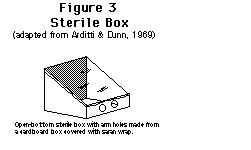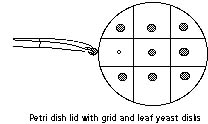
Leaf Yeasts as a Bioindicator of Air Quality
by Boris and Ludmila Berenfeld
Project overview
The pristine surface of a new leaf is colonized rapidly by fungi and bacteria whose spores are dispersed widely and abundantly throughout the air. One species of sac-fungi, Sporobolomyces roseus (pink leaf yeast), has been chosen by researchers as a useful potential indicator of air quality because:
- Counts of its colonies have been shown to vary with air quality
- Its ability to forcibly expel spores makes it easy to isolate in pure culture.
Counts of leaf yeasts have been pioneered by an association of ecologists in Dublin, Ireland, and conducted in many European countries. School children have played a critical role in data gathering. Now French school children found that trees in parks had higher leaf yeast counts than those growing in the rest of the city. The Irish students found low leaf yeast counts downwind of industrial plants and in urban valleys, but found higher counts in the countryside, by the seaside and in city parks.
At the moment, a decrease in leaf yeast counts is only an indicator of problems of air quality. It is usually hard to identify the particular pollutants responsible for lower than usual counts; sulfur dioxide (SO2), alone or in combination with other pollutants, is the most likely, but still unproven, suspect. A considerable amount of SO2 is natural, and can be found in systems as diverse as volcano emissions and sea spray. But the greatest amount of SO2 is made artificially, as a by-product of the production and burning of fossil fuels containing sulfur.
 San Antonio,
Texas students studied leaf yeasts and named their team the Leaf Beasts.
San Antonio,
Texas students studied leaf yeasts and named their team the Leaf Beasts.
Laboratory and Field Activity
Overview of the procedure
In this activity, adapted from the european studies cited below, teams of students will collect leaf samples in the field and then make cultures of leaf yeasts to determine relative levels of pollution. Before the project begins you will have to pick an area that you want to study. The activity itself spans seven to nine days.
The first day requires about one period to prepare the Petri dishes. If you cannot order Petri dishes with malt agar, you will have to make your own and this will require an additional hour. On the morning of the second day student teams will collect leaves from their areas. That afternoon, they will prepare cultures in the laboratory that will sit at room temperature for four days. They can be unattended during this time, except that 24 hours after the Petri dishes were prepared they must be flipped over to stop any new spores from reaching the agar surface.
4-6 days after flipping, students will open the Petri dishes and record and analyze the colonies growing inside.
General Preparation
Pick an approximately 10 square kilometer area to test and buy a map of this area. You might want to sample in areas in which physical monitoring has shown continuously high or low air quality so that you have a standard by which to measure your results. Ask your local health officials, hospital administrators, or environmental protection personnel where such measurements have been taking place. You should also make a decision about what species of tree you want to take your samples from.
Materials
· Each team requires 9 Petri dishes with lids, containing agar with malt extract. These can be purchased already prepared, or prepared in the laboratory using:
· 9 Petri dishes with lids
· 20 g malt extract
· 20 g agar
· 1 liter water
· Flask for melting agar
· Pipette (optional)
· Tape
· Pen to mark date and to indicate position of each disk
· Borer (disc maker) 0.5 cm in diameter. A way to make your own borer is to remove the eraser from a pencil. The resulting disc maker works well, but you will have to measure its diameter and make an adjustment to the calculations which assume 0.5 cm disks!
· Tweezers/forceps for placing disks in Petri dishes
· Plastic bag for leaves; one bag per tree
· Petroleum jelly (Vaseline) or cellulose paste (water-based and non-fungicidal)
· A map of the area you want to study.
Precautions To Prevent Contamination
When you are preparing your Petri dishes and later when you put your samples in them, bacteria and yeasts from the air can enter; the colonies that grow from these bacteria and yeasts can make it more difficult for you to see your pink leaf-yeast colonies.
Always wash your hands before handling the Petri dishes or samples and never bring food near your work area. Clean your work surface with rubbing alcohol before each step of the procedure.
If you cannot purchase sterilized Petri dishes then purchase glass Petri dishes and sterilize them yourself in an autoclave or a pressure cooker.
You can also fashion a simple sterile box from cardboard, cellophane, and aluminum foil that you can use whenever the Petri dishes are open.

Day 1 Preparing the Petri dishes
1. If your Petri dishes already contain malt extract agar skip steps 2, 3, and 4.
2. Make malt agar
· Put 20 g of malt extract, 20 g of agar, and 1 liter of water in a flask and plug with cotton (makes 70-100 dishes)
· Immerse this flask in a larger pot of boiling water.
3. When the agar solution is warm and clear, transfer about 20 ml into each Petri dish, either by pouring or using a pipette. The agar should be approximately 0.5 cm deep. Cover the dishes with their lids.
4. Let the Petri dishes stand at room temperature without touching or opening them until the agar hardens, then store them in a refrigerator. The surface of the agar must be smooth.
5. Draw grids for 9 leaf disks on the upper surfaces of the closed dishes. This will ensure the correct distribution of leaves and easier counting.

6. Label the Petri dishes, both top and bottom, with
letters A1, A2, B1, B2, C1, C2 etc.
Day 2 (morning): Out in the field
1. Do not collect samples during or within a week of a heavy rain; rain can decrease counts by washing leaf-yeasts off of the leaves. Since weather can affect leaf-yeast growth you should record the temperature, rainfall, and any unusual conditions, such as an extremely strong wind, for one week prior to the day of collection.
2. Divide your students into teams of about 3 members. Divide the area you want to test into 1 km2 squares on the map. Assign each team of students to a square.
3. Each team should select 4 trees of the same species if possible (ideally ash, but if not ash, then sycamore, apple, maple, or lilac) within their square. Try to select one from the center and the others around it and mark their positions on a map. Do not select trees that have bare branches or discolored (not green) leaves.
4. Collect two leaves from opposite sides of each tree and place them in a plastic bag. Do not take leaves that are at the end or beginning of a branch or that are larger or smaller than average. Record the approximate height above the ground and distance from the trunk of the spot from which you took your leaf.
Day 2 (afternoon): Back in the Laboratory
1. Place the leaves top down against clean paper, underside facing up. Cut nine 0.5 cm diameter discs from each leaf.
2. Open nine Petri dishes. Replace the lids upside-down on the dishes while you work to minimize the time they are open to the air. Attach the disks by their underneath surface to the underside of the Petri dish lids using a small blob of petroleum jelly placed on the lids.
When the lids are replaced the smooth topside of the leaf should be pointing down so the spores can be "shot" into the agar. Replace the lids on the Petri dishes. Tape them shut. Each team should have had one 'extra' dish. This control dish should be left open for the same amount of time as the other dishes so you can see how many pink colonies grow just from the yeast in your air.
3. Tape the nine Petri dishes together in a stack and let them sit, lid-uppermost, at room temperature. Keep them out of the sunlight.
Day 3 (5 minutes)
Invert each pile of dishes after 24 hours (it is important to be as exact as possible about the time), and let them sit for 4-6 more days in the same conditions; no more spores can fall but the colonies will continue to grow.
Day 7-9 Data Collection
Record below the number of pink yeast colonies in each Petri dish. You can make separate observations
for different sites, sides of tree, size of leaves etc.
Sq.# Disc No 1 2 3 4 5 6 7 8 9
Tree A1
(Leaf 1)
(Leaf 2) Etc.
1. Count the number of pink colonies under each leaf disk.
2. Average the eight leaf yeast counts from each square.
3. Record on your map squares the average leaf-yeast counts.
Make a relative grouping of your leaf yeast counts. One Irish study, after examining their data, grouped data like this:
0-20 Low counts. Relatively poor quality air?
21-50 Moderate counts. Moderate quality air?
Above 50 High. Relatively good quality air?
We neither know the baseline of leaf yeast colonies for your area, nor how much air pollution will cause the counts to vary from the baseline. We can slowly fill in the gaps in the baseline data by collecting data from as large an area as possible, and correlating the data with physical measurements of pollutants.
Brainstorming questions:
Does your distribution of colonies show any pattern?
How could you investigate further?
What other factors might have influenced your results?
Leaf yeasts counts are responsive to changing weather, their numbers increasing with higher humidity and decreasing with drought.
Are there any physical/chemical assessments of suspended particles in the air or of SO2, Ozone, Acid Rain, CO2 you might correlate with your data?
Further readings
Dowding, P. (1987). "The Use
of Leaf-yeasts as Indicators of Air Pollution." In Biological
Indicators of Pollution,
ed. by D.H.S. Richardson, Royal Irish Academy, Dublin, pp.137-53
Dowding, P. and D.H.S. Richardson
(1990). "Leaf yeasts as indicators of air quality in Europe." Environmental
Pollution. 66.23-235.
Ni Lamhna, E., D.H.S. Richardson,
P. Dowding, and K. Molloy (1985). Air Quality Survey of the South Coast
(Waterford and E. Cork) carried out by Schoolchildren. Dublin: An Foras Forbatha.
Thierry, F., M. Lerond, A. Brunel
(1988). "Suivi de La Qualite de L'Air Par Les Levures." Rouen,
France: Centre du Documentation sur le Milieu Naturel.
© copyright 1991, the Technical Education Research Centers. Adapted with permission. Global Lab Project